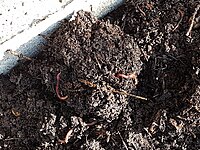
Photo from wikipedia
Modern agriculture is dependent on phosphate rock (PR), which is a nonrenewable resource. Improvement of phosphorus (P) availability for crops in agricultural soils represents a key strategy to slow down… Click to show full abstract
Modern agriculture is dependent on phosphate rock (PR), which is a nonrenewable resource. Improvement of phosphorus (P) availability for crops in agricultural soils represents a key strategy to slow down the depletion of PR. The aim of this study was to identify potential P biofertilisers among saprotrophic fungal species. We tested 30 fungal strains belonging to 28 taxa (4 Zygomycota and 24 Ascomycota) and with different life strategies. The study showed that many saprotrophic fungi have the ability to mobilise P from insoluble forms according to a variety of mechanisms. Our results expand the pool of P solubilising fungal species, also suggesting a new solubilisation index and shedding light on parameters that could be basic in the selection of efficient soil P-biofertilisers fungi. Rhizopus stolonifer var. stolonifer, Aspergillus niger and Alternaria alternata were found to be the best performing strains in terms of amounts of TCP solubilisation.
Journal Title: Ambio
Year Published: 2017
Link to full text (if available)
Share on Social Media: Sign Up to like & get
recommendations!